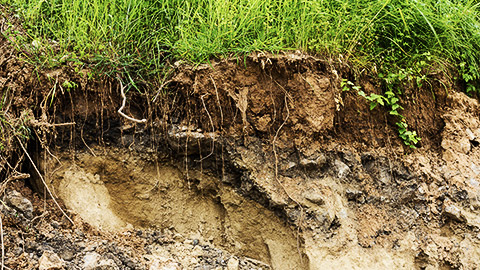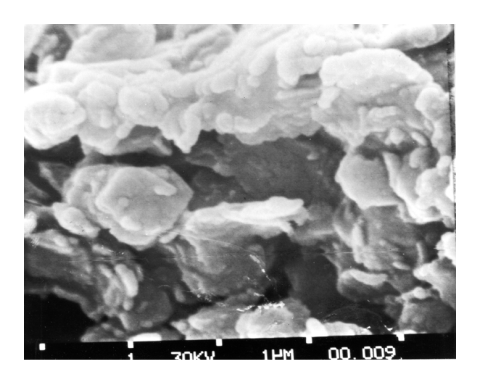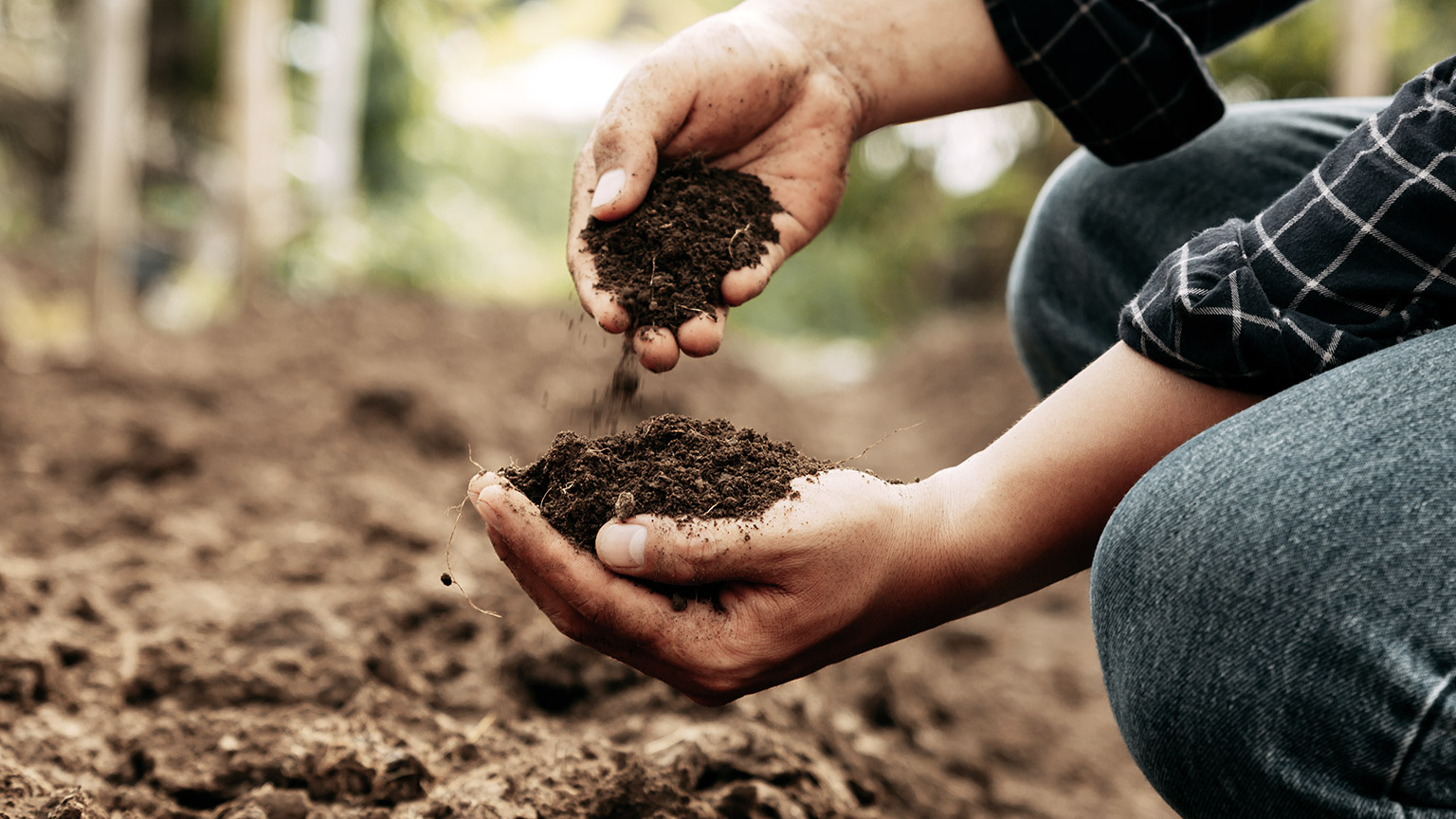Do you remember the components of soil? See if you can complete this short activity correctly.
In this topic, we’re going to build our understanding of each of these soil components:
- Mineral
- Water
- Gasses
- Organic matter.

Mineral particles are important because they provide the plant with something to anchor it in.
In soil that is ideal for growing plants, mineral particles make up about 45% of the volume of the soil.
The size of the mineral particles in the soil determines how the soil feels and this is called soil texture, or soil type.
The size of the particles also contributes to the structure of the soil. Remember that soil structure describes how well individual particles, like sand, silt, and clay, (as well as organic matter) clump together to form aggregates.
Source: fao.org
These factors in turn determine:
- what we can grow in the soil in its current state
- what we need to do to modify the soil if we want to grow different plants
- how we manage the soil to ensure our plants have access to enough water and nutrients.
Sand
Apart from stones or pebbles, sand particles are the largest soil particles. Rocks are not considered part of the soil.
Different databases will give size ranges to define sand, silt, and clay, but for our purposes, we’ll use those given in the National Soil Data Repository (NZDR) which is maintained by Manaaki Whenua, Landcare Research. This resource defines sand particles as being in the range of 2.0-0.06mm. This means they can be seen with the naked eye.
Sandy soils are highly porous meaning they have large pore spaces between particles which allow water to run through them quickly. Additionally, sand particles do not pack tightly together like other soil types, which helps prevent compaction of the soil.
As a result, sand isn’t good for growing most plants because it doesn’t hold water or nutrients very well. However, when the environment requires good drainage and low compaction, for example on the putting greens of golf courses, sand can be an appropriate growing medium.

Note the colour of the soil in the pathway is much lighter than the soil on the sides of it, which has plants growing in it. This suggests that the farmer amended the sandy soil to make it more suitable for crops to grow.
Silt
Grains of sand that are worn down into smaller particles are called silt. Silt particles are defined as being in the range of 0.06-0.002mm. You’ll need a magnifying glass or a microscope to see silt particles.
Silt typically holds more water and nutrients than sand but less than clay. Because of its small particle size, silt can travel long distances when washed by water or blown by the wind. When silt is transported into waterways in large enough quantities it can block fish gills from working properly, smother fish habitat and encourage slime algae growth. When this happens, it is referred to as siltation and considered a pollutant.
After the earthquake in Christchurch, the rivers took on so much silt one researcher at Canterbury University believes it will take decades to recover from the damage, as described in this Stuff article.
Clay
Clay is a type of natural soil material that is fine-grained and contains clay minerals (hydrous aluminium phyllosilicates). There are different types of clay minerals such as kaolinite, illite, and smectite.
For our purposes, anything smaller than 0.002mm is considered clay. Particles can only be broken down this small through chemical processes.
You’ll need an extremely powerful microscope to see individual clay particles – one with a magnification of 1000x or more!

Clay minerals are typically formed through the weathering and alteration of rocks that contain silicate minerals. This process involves breaking these down into smaller particles, and then transforming them into clay minerals by chemical reactions with water and other substances.
Once the silicate minerals have been broken down into smaller particles, they undergo a series of chemical reactions with water and other substances, such as carbon dioxide, to form clay minerals. The process typically involves the formation of complex crystal structures, which can result in the formation of different types of clay minerals.
Overall, the formation of clay minerals is a complex process that is influenced by a range of physical and chemical factors, including the composition and structure of the original rock, the climate and environment, and the presence of other substances that can influence the chemical reactions involved in the process.
Wikipedia contributorsMost pure clay minerals are white or light-coloured, but natural clays show a variety of colours from impurities, such as a reddish or brownish colour from small amounts of iron oxide.
Clay soils generally have a high cation exchange capacity (CEC) because they are formed through chemical processes that result in the formation of a high surface area and a negative charge on the clay particles. We’ll talk about CEC later in this module.
Clay become malleable (can be formed into shapes without breaking) when wet because it attracts and holds a molecular (super-thin) film of water around each particle.
Air takes up space in the pores of the soil.
In soil that is ideal for growing plants, air makes up about 25% of the volume of the soil.
Air in the soil is essential for:
- animals, such earthworms, need air to breathe
- other soil biology, such as fungi and bacteria, need oxygen to survive
- plants need to be able to access air from the soil for cellular respiration.
When soil doesn’t have enough air in it will lead organic matter to rot (anaerobic decomposition) which creates unpleasant gasses and leaves left over material in the soil that is not good for plants.
When the pore spaces of soil are filled with water for long periods – in other words when there isn’t enough air – gleying and mottling can occur.
| Gleying (or gley soil) | The gray, blue, purple or green soil colours that occur in soils that have been waterlogged for prolonged periods of time. Anaerobic microbes flourish in the absence of air, reducing iron and manganese minerals. The chemical reduction of iron and manganese produces the characteristic gley colors. Source: Soilsfacstaff |
|---|---|
| Mottling (or mottled soil) | Mottling is the name given to spotted or streaked areas of colour (mottles) in soil. Mottling is usually associated with periodic wetting. Mottles come in a variety of colours but will often be browny-orange. Source: NZSoils |
Both gley and mottled soils can give off gas due to anaerobic microbial activity. Anaerobic microbes in the soil can break down organic matter and produce gases such as methane (CH4), carbon dioxide (CO2), and hydrogen sulfide (H2S).
The production of gases can have significant environmental implications. Methane is a potent greenhouse gas that contributes to climate change, while hydrogen sulfide can be toxic to plants and animals in high concentrations.
Therefore, proper soil management practices that promote aerobic (air in the soil) conditions and minimise waterlogging can help to reduce gas production in gley and mottled soils.

In a soil that is ideal for growing plants, water makes up about 25% of the volume of the soil.
Water is held in the soil through a number of processes:
- It is held on the surface of the clay particles by a process called adsorption. Clay particles have a high surface area, which means that there are many sites on the surface of the clay particle where water molecules can interact. These sites have a negative charge due to the presence of minerals such as aluminum and silicon in the clay structure.
Water molecules, on the other hand, have a partial positive charge due to the arrangement of hydrogen and oxygen atoms in the molecule. This means that they are attracted to the negatively charged sites on the surface of the clay particles. As a result, water molecules can adhere to the surface of the clay particles through electrostatic forces, forming a thin layer of water around the particle. - It is held on the surface of silt and sand by adsorption somewhat, but more so through capillary action. Capillary action occurs when the surface tension of water causes it to rise through small spaces, such as the pores between soil particles. The smaller the spaces, the higher the water can rise through capillary action.
- It is held in organic matter through absorption – think of it like sponge.
Water movement in soils
The process of water entering the soil is called infiltration and the process of water draining down through the soil is called percolation. We’ll look at these factors later in the course.
Hydrophobicity
In some cases, the soil surface will become hydrophobic. Hydrophobicity is where the soil becomes water-repellent or water-resistant, meaning that it does not easily absorb water. This condition occurs when organic matter or other substances coat the soil particles, creating a waxy or oily layer that repels water.

Image and quote source: Neutrog.com.auThe inability of soils to take up water is really down to the waxy coating on soil particles. These waxes come from either soil microbes or plant material which hasn’t broken down completely (Eucalyptus leaves are a great example).
When conditions become unfavourable, microbes secrete compounds which make the soil water-repellent sandy soils, only about 2-4 % of the particles need to be coated for water to be repelled, and for clay soil, it’s about 10%.
Hydrophobicity can occur naturally in soils with high organic matter content, such as forest soils or peatlands, but it can also develop due to human activities such as excessive tillage or use of certain chemicals. It can be made worse by drought conditions, which can cause the soil to become extremely dry and the hydrophobic layer to become thicker.
Managing soil water
Making sure that your soil has the right amount of water – not too little, not too much – is called soil water management. We’ll look at this in more detail later in the course.
Earlier, we talked about the fourth component of a soil being organic matter, but it’s probably better to think of it as biological matter.
This covers two distinct parts:
- Dead and decaying organic matter — animals and plant materials
- Living organisms — invertebrates and microorganisms primarily.
In a soil that is ideal for growing plants, biological matter makes up about 5% of the volume of the soil.
Some people refer to the biological matter in the soil as the soil food web. The soil food web is a complex system of interactions between living organisms in soil that support plant growth and health. It includes a wide range of organisms such as bacteria, fungi, protozoa, nematodes, arthropods, and earthworms, which are interconnected through food chains and nutrient cycling.
This short video by the Soil Food Web School provides a quick overview of the soil food web:
At the base of the soil food web are primary producers, such as plants and algae, which capture energy from the sun through photosynthesis and convert it into organic matter. This organic matter is then consumed by primary consumers such as bacteria, fungi, and protozoa, which break down the organic matter into simpler compounds and release nutrients that are available for plants to absorb.
Higher-level consumers, such as nematodes, arthropods, and earthworms, feed on the primary consumers and contribute to the breakdown and recycling of organic matter. These organisms also help to improve soil structure and water retention, enhance nutrient cycling, and promote plant growth and health.
The soil food web is important for maintaining soil health and fertility. Understanding and managing the soil food web can help to promote sustainable agriculture and protect soil ecosystems.
The soil food web can be disrupted by human activities such as excessive use of synthetic fertilisers, pesticides, and tillage. Being aware of this can help us make decisions about what to do and what not to do in the garden.
Mycelium
Mycelium is a root-like structure of a fungus, consisting of a network of thread-like structures called hyphae. Mycelium is typically found in soil and decaying organic matter where it plays a crucial role in nutrient cycling and decomposition.
Mycelium has the ability to form mycorrhizae, a mutually beneficial relationship between fungi and plant roots. Mycorrhizal fungi colonize the root systems of plants and help them absorb nutrients from the soil, particularly phosphorus, which is often limited in agricultural soils. In exchange, the fungi receive sugars from the plant.

Nitrogen fixation
This is the process by which atmospheric nitrogen (N2) is converted, or “fixed”, into usable forms of nitrogen (ammonia, NH3; ammonium, NH4+; nitrate, NO3+) by certain bacteria, some types of fungi, and other soil microorganisms.
Atmospheric nitrogen is present in large quantities in the air, but it is not in a form that most organisms can use. Nitrogen fixation involves biological reactions that are catalyzed by specific enzymes, called nitrogenase.
These enzymes are produced by certain bacteria, such as cyanobacteria (blue-green bacteria) and rhizobacteria. Cyanobacteria can fix nitrogen in soils, freshwater, and marine environments. The forms of nitrogen they produce in the soil can be absorbed by plants.
Rhizobacteria are known as root-associated bacteria, meaning they carry out nitrogen fixation in the roots of certain plants – in areas called root nodules. The plant provides the bacteria with the amino acids and oxygen it needs to survive and the bacteria in turn provide the plant with nitrogen to help it grow. The plants are high in nitrogen, so when they die and decompose, they contribute nitrogen back into the soil.
Many species of legume – such as clover, lucerne (alfalfa), and lupins – are nodule-forming plants, as are a small number of other plants, such as alders

Soil microorganisms in action
In the following video, Terry Tollefson provides some excellent scenes of soil microorganisms through a microscope:
Benefits of a healthy soil food web
According to the Bragato Research Institute, A healthy soil food web provides the following benefits:
- increased nutrient cycling
- increased soil carbon sequestration [the process of capturing and storing carbon dioxide (CO2) from the atmosphere]
- increased soil aggregation
- alleviates soil compaction and anaerobic conditions
- increases water infiltration rates
- increased water-holding capacity and drought resilience
- increased resilience to soil erosion.
